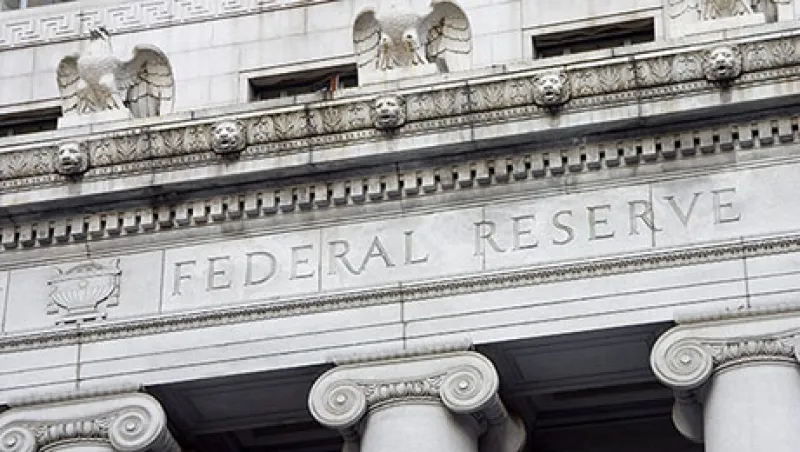In December the Federal Reserve Board published a paper proving what everyone in the bond market already knows: The Volcker Rule — a provision in the 2010 Dodd-Frank Wall Street Reform and Consumer Protection Act aimed at restricting proprietary trading and risk-taking by banks — has had a severe impact on liquidity in the bond market. Some hedge funds and other investors have played this to their advantage. But the paper’s authors raise fresh concerns that these opportunistic investors may not stick around when times get tough.
An unintended consequence of the Volcker Rule, which was designed to limit risk-taking on the part of too-big-to-fail banks, has been to increase the level of risk in the bond markets at times of great market stress, because liquidity dries up. Unable to profitably trade their own capital, the big banks have cut back on their market-making functions. On the bright side, hedge funds and other opportunistic investors have stepped into the void. But these investors do not have an obligation to fulfill a market-making role, meaning they can exit when times get tough — which leads to further illiquidity.
The paper’s authors — Jack Bao, Maureen O’Hara, and Alex Zhou — argue that in the $8.6 trillion corporate bond market, “bond liquidity deterioration around rating downgrades has worsened following the implementation of the Volcker Rule,” and that this is problematic because, given how severely liquidity dried up during the height of the financial crisis, “this finding suggests that the Volcker Rule may have serious consequences for corporate bond market functioning in stress times.”
The paper focuses on investment-grade bonds that are downgraded, resulting in forced selling. The authors found that these downgraded bonds experienced more price volatility than a control group of securities that already had the same rating.
“More importantly,” the authors write, “the relative level of the excess price impact is larger after the Volcker Rule is implemented than the period just before the Volcker Rule is implemented. Indeed, we find the disturbing result that illiquidity in stress periods is now approaching levels seen during the financial crisis.”
Bao and Zhou, both economists with the Federal Reserve, and O’Hara, the Robert W. Purcell Professor of Finance at the Johnson Graduate School of Management at Cornell University, did find evidence that new, non-Volcker-affected participants are stepping into the breach. But, they warn, “at least during stress times, this new participation is not yet enough to offset the decreased liquidity in bond market trading.”
The lack of market makers is only one of a few significant changes that have affected the credit markets in recent years. Others include the massive rise of electronically traded funds, or ETFs, that invest in bonds; the trend toward passive, or indexed, investing; and the increase in electronic exchanges for bonds. Some savvy hedge fund managers have been able to benefit from these structural changes — including the $5.5 billion Mariner Investment Group, which has been able to profitably arbitrage the bond markets.
“The structural changes of the market created opportunities for us,” says William Michaelcheck, Mariner’s founding partner, chairman, and CIO.
At a time when there are fewer market makers, more debt is being issued than ever before; Mariner makes money by taking advantage of price dislocations. The firm continues to take advantage of arbitrage opportunities in the traditional bond markets, but it is also increasingly finding trading opportunities in ETFs and other synthetic indexes, such as futures. When its portfolio managers think a bond index is mispriced, often due to a market event, Mariner can go in and buy up the ETF, hedging it against a comparable index — such as a stock index made up of the same companies — and wait for the price gap to close. A trade can last a couple of days or a couple of weeks, Michaelcheck says.
One advantage is that it easier for the firm to put a trade like this on at size, rather than investing in individual bonds. Mariner is seeing more of these opportunities in the high-yield bond index, in part because of the lack of market making in the underlying bonds.
Yet even as hedge funds like Mariner are profiting from the new market structure, Michaelcheck recognizes the danger to the overall markets.
“There is nowhere near the depth and strength in the market that there was historically,” says the long-time fund manager. In times of extreme market stress, a fund like Mariner, which uses very little or no leverage, is going to exit the market in the short term. However, a little volatility only helps their arbitrage.
Not all hedge fund managers are embracing the new market environment, however. For fundamentals-focused fund managers, a massive price dislocation promises to be a very challenging time, as it was in 2008. This time around hedge funds are for the most part more focused on ensuring that their assets and liquidity needs match up — so they have sufficient runway to outlast any technical markdowns — but more liquid ETF and retail strategies that have developed since 2008 often require daily liquidity, even in bonds.
The incoming Trump administration and GOP Congress have pledged to make repealing Dodd-Frank a priority, and banks are especially keen to see Volcker rolled back. But such promises are not enough to silence the alarm bells ringing in the bond markets today.






